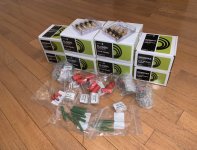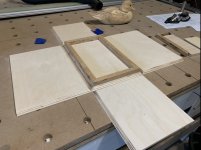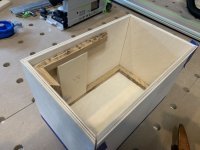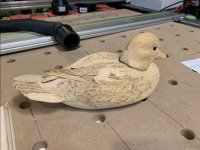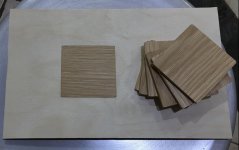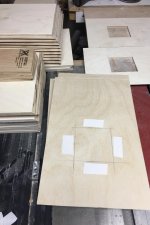XPS covered with a thin 1/4in or veneer with a pliable adhesive like latex caulking might make a great CLD wall and provide better sound than wood or XPS alone.
I did that yesterday. Good dampening of the main resonances. I did a number of other boxes all using 1/4" MDF as the inner and outer skin, but changing the constrained layer. Surprisingly simple Weicon Flex 310M adhesive has a slight edge over XPS foam IMO, and 1/4" Nidacore was also good, and relatively cheap. One thing to consider is these are unbraced boxes, so when you brace them I expect the resonances to be pushed up into 800-3000hz area, where the Flex 310M and Nidacore are bit more effective than the XPS. I mention this because the Flex 310M box is basically just 1/2" overall thickness MDF, so the main resonance is lower and the XPS box, making it appear worse <400hz but in reality these boxes would be braced and that area would probably perform similarly for all the boxes. The difference would then be which boxes dampen the 800-3000hz area. That's my hypothesis anyway. FYI both Nidacore and XPS were glued with Loctite PL300.
An externally hosted image should be here but it was not working when we last tested it.
An externally hosted image should be here but it was not working when we last tested it.

I dropped off the drivers at my cabinet maker’s shop today and saw that we are making great progress: all the wood for the panels has been cut and mitered. Checking the dry fit before glue. The battens are mitered as well and held together with a “V” art framing staple and glue. The white oak is salvaged from a 150yr old barn that was being razed. Very dense and hard wood - a shame to hide it inside the cabinet. I also found out that he is a very talented sculptor too - a wooden duck model carved from basswood meant for museum displays.



Attachments
Shaping up nicely X.
Your cabinet maker is really good with his hands - very nice handiwork with the duck sculpture there!
Your cabinet maker is really good with his hands - very nice handiwork with the duck sculpture there!
There is something very cool knowing that the internals contain wood from a 150yr old barn in Virginia. Basically there during the Civil War. 😎
So we are going to make a small plaque out of the antique 150yr old barn white oak and inlay it into the back and then laser engrave the speaker name, specs, etc on the back. This speaker will have to be finished with BLO. No other choice.
Hi X
What value resistors did you end up ordering? The schematic shows 13.3 Ohm and 12 Ohm but those values are not available from PE in the type you show in the parts pile.
Two 6 Ohm and two 6.5 Ohm could work for 12 and 13 Ohm. Or a 3.3 and 10 for 13.3. It seems like there should be more resistors shown in your order.
Thanks for putting this speaker together.
What value resistors did you end up ordering? The schematic shows 13.3 Ohm and 12 Ohm but those values are not available from PE in the type you show in the parts pile.
Two 6 Ohm and two 6.5 Ohm could work for 12 and 13 Ohm. Or a 3.3 and 10 for 13.3. It seems like there should be more resistors shown in your order.
Thanks for putting this speaker together.
Thanks for your interest. I ended up getting the 12.5ohm for the 12ohm. And a 12.5ohm plus 1.0ohm for the 13.5ohm. This way I only had to buy two kinds of resistors. I used the new 1% green wire wound resistors from Dayton. For the caps, I used a 10uF plus 1uF for the 11uF. The 4.7uF is a single cap. I used Audyn Q4 MKPs. For the inductor, I used an 18ga iron core 5mH from Dayton and a 20ga aircore 20ga from Jantzen.
Last edited:
Hi xrk:
A quick question. Based on the curves you showed on p. 1 of this thread, the "apparent" crossover point of your homage is around 5K, which is kind of high even for a 5.25" mid-bass driver. Does the speaker have a significant change in directivity in this region?
I wonder whether the good vocal reproduction of the speaker is the result of the "splash" of higher frequencies caused by the directivity change being pushed outside the range of 300Hz-3000Hz. If so, maybe it also explains why some people like to add super-tweeters to their 8" fullrange drivers.
Kurt
A quick question. Based on the curves you showed on p. 1 of this thread, the "apparent" crossover point of your homage is around 5K, which is kind of high even for a 5.25" mid-bass driver. Does the speaker have a significant change in directivity in this region?
I wonder whether the good vocal reproduction of the speaker is the result of the "splash" of higher frequencies caused by the directivity change being pushed outside the range of 300Hz-3000Hz. If so, maybe it also explains why some people like to add super-tweeters to their 8" fullrange drivers.
Kurt
I have not measured polars yet but I do think part of the reason why vocals sound good is that the entire “radio band” up to 5kHz (where vocals are important) is captured by a single driver. Sort of like a single full range augmented by a tweeter. Having vocals from a single source provides a coherent sound that is more natural.
Nice touch and tribute to the barn. Speakers are coming along well too. Not sure where you find all the energy but keep at it, amazing work..dB
Thanks for the info on the resistors. Everything is ordered.
Had to go with the dayton inductors as the Jantzens were out of stock.
Nice touch with the barn wood panel. Old wood has such character.
Had to go with the dayton inductors as the Jantzens were out of stock.
Nice touch with the barn wood panel. Old wood has such character.
Nice touch and tribute to the barn. Speakers are coming along well too. Not sure where you find all the energy but keep at it, amazing work..dB
Thank you, DBel84. It’s a team effort. I cannot do all of this myself of course. The design and plans are mine but the woodworking is by my master craftsman cabinet maker.
I agree with that part. A lot of people tend to lean towards full range because they want the coherence. But I find coherence is only really necessary in the radio band.I have not measured polars yet but I do think part of the reason why vocals sound good is that the entire “radio band” up to 5kHz (where vocals are important) is captured by a single driver. Sort of like a single full range augmented by a tweeter. Having vocals from a single source provides a coherent sound that is more natural.
Oon
Maybe this is the inverse of FAST/WAW? Super Tweeter Assisted Fullrange Technology (STAFT). 🙂
STAFT sounds better than TAW, which is almost as bad as WAW.
Not to be confused with Staph (as in stapholococcus infection).
But then maybe 5k5 is not quite super tweeter terrirtory yet so name is really
TAFT, which, is actually a real name of a former US president. 🙂
STAFT sounds better than TAW, which is almost as bad as WAW.
Not to be confused with Staph (as in stapholococcus infection).
But then maybe 5k5 is not quite super tweeter terrirtory yet so name is really
TAFT, which, is actually a real name of a former US president. 🙂
Last edited:
- Home
- Loudspeakers
- Multi-Way
- RST28F and DC130A Foamcore Homage to LS3/5A
